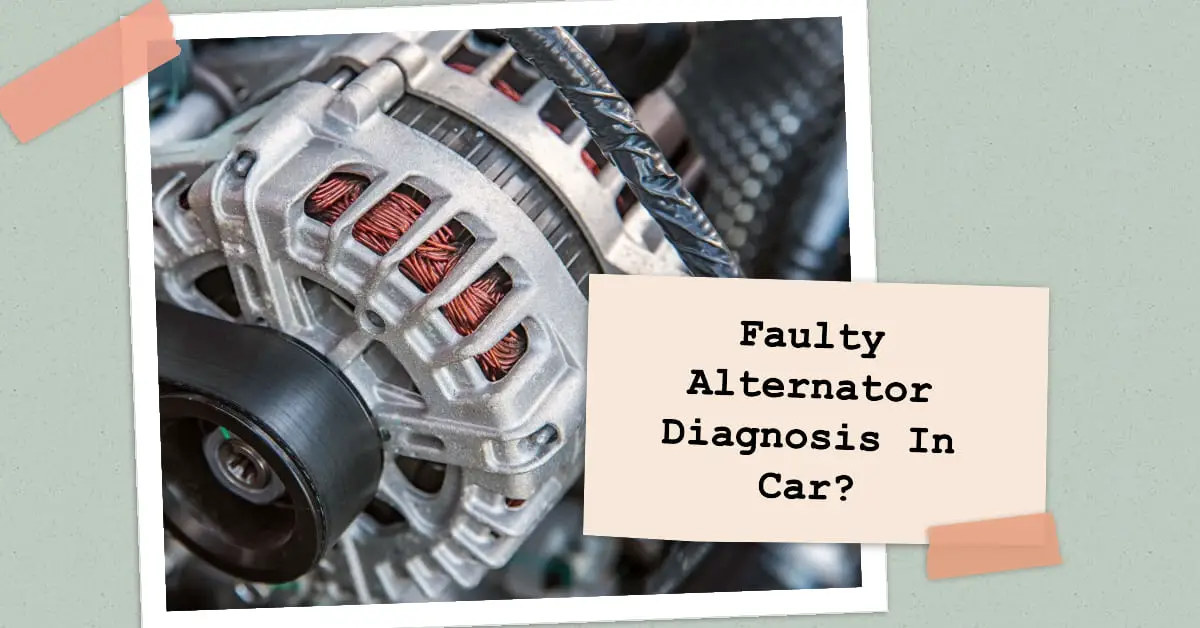Diagnosing a Faulty Alternator: Case Study for DIYers

Cranking the key on those frigid winter mornings, flipping on your high beams as dusk settles in, blasting the A/C on sweltering summer days – these all depend on your alternator functioning properly. This humble underhood component powers your vehicle’s entire electrical system while the engine runs, keeping the battery charged and supplying juice to all electronics. So when that trusty alternator finally fails after years of faithful service, your ride is going nowhere without a jump start.
Doddering along with a dicey alternator can leave drivers stranded or performing hasty roadside repairs. But accurately diagnosing a faulty alternator yourself rather than simply replacing parts can save time, money, and headaches. This in-depth case study will provide DIYers an alternator autopsy of sorts – exploring how to definitively determine if failure is imminent and if replacement or repair is required.
We’ll cover the quick backyard tests anyone wielding a multimeter can perform to check for problems. But we’ll also dive under the hood to diagnose root causes like bad diodes, belt slippage, bearing wear and more. You’ll learn to expertly interpret voltage readings and warning signs to avoid getting left in the lurch.
Can you accurately diagnose a failing alternator and determine if replacement is needed? Let’s crack this case wide open!
Table of Contents
An Introduction to the Alternator – What Does it Do?
Before launching into diagnosing problems, a quick refresher on what exactly this gizmo does might help. The alternator is a bit like an electrical generator, producing power to keep the battery charged and electrical components humming. It’s belt-driven, spinning along with the crankshaft via the serpentine belt.
Inside are wire coils called “stator windings” that rotate within the magnetic fields of the rotor. This generates alternating current (AC) which gets converted to direct current (DC) to charge the battery and run electronics. Those diodes are key – when they fail, charging stops.
So in a sense, the alternator “generates” electricity rather than “storing” it like the battery. It’s a brilliantly simple device, converting mechanical rotation into the electrical current that powers your cornering lights, radio, heated seats and everything else electrical.
Knowing the basics of how an alternator works provides helpful context for diagnosing problems – often traced back to failure of those winding coils or diodes. Next, let’s explore the common symptoms exhibited when an alternator starts fading.
Pay Attention to These Common Alternator Failure Symptoms
Catching the early warning signs of a dying alternator gives you a chance to diagnose before being left stranded. Here are the most common indicators that your alternator may be on the fritz:
Dimming Headlights
As alternators fail, they generate less steady voltage. So you may notice headlights dim at idle but get brighter when revving the engine. The additional RPMs allow the failing alternator to temporarily produce more power. But the underlying issue remains.
Electrical Components Turning Off
When underway, the voltage may intermittently drop low enough that electrical components simply cut out. You might experience the headunit shutting off, rear camera going blank, or warning chimes sounding. As voltage from the battery or alternator dips, sensitive electronics lose power.
Battery Warning Light Illuminated
Most vehicles have a battery or charging system warning light on the dash. It illuminates when the alternator isn’t producing enough voltage to charge the battery. This indicates lower electrical system voltage caused by a faulty alternator.
Battery Drains or Won’t Hold a Charge
Your battery acts as an electrical reservoir, storing energy until needed. But a failing alternator can’t keep the battery properly charged as you drive. The battery drains rapidly, causing hard starts or even leaving you stranded with a dead battery if unchecked.
AC Blower Motor Stops or Battery Dies at Idle
If the A/C fan cuts out when at a stop, it may indicate the weak alternator can’t provide sufficient amps to power it when RPMs are low. Similarly, stalling or the engine dying at idle points to the alternator being unable to keep battery voltage steady.
Any of these symptoms suggest the alternator may be failing. But how can you confirm the alternator is actually the culprit? Let’s explore some DIY testing methods.
Using a Multimeter Voltage Test to Check Alternator Health
The quickest and simplest way to assess alternator performance is a voltage test. This can be performed with an inexpensive multimeter available at any auto parts store.
Voltage testing with the engine off and running reveals if the alternator is producing power within the proper range to keep the battery charged. Here is a step-by-step voltage test:
Voltage Test With Engine Off
- Connect multimeter red lead to positive battery terminal, black lead to negative terminal.
- With engine off, check voltage reading on multimeter. Healthy, fully charged battery should show 12.4 – 12.6 volts.
- A reading lower than 12 volts indicates discharge or possible battery issue.
- If battery voltage checks out, it’s on to testing the alternator with engine running.
This first voltage check provides a baseline reading to compare the running voltage against in the next steps.
Testing Charging Voltage With Engine Running
- With multimeter leads still connected to battery terminals, start the engine.
- Check the multimeter reading again with engine idling. Voltage should show between 13.5 – 14.5 volts if alternator is charging properly.
- Rev engine slightly above idle. Voltage reading should climb slightly, indicating increased charging from the alternator.
- Turn on all electrical accessories – lights, heating fan, radio. Voltage may drop slightly but should remain in the 13.5+ range if the alternator is working correctly.
- If voltage reading fails to climb when starting the engine or drops below ~12 volts with accessories on, the alternator likely cannot provide proper charging current.
This running voltage test checks whether the alternator is producing power in the ~14V range needed to charge the 12V battery system. Simple and easy to perform with just a multimeter.
Interpreting Voltage Readings
Baseline voltage below 12V – Battery not fully charged
Running voltage below 13.5V – Alternator not charging properly
Voltage drop when revving – Alternator failing
Big voltage dip with accessories on – Weak alternator output
Using a multimeter to check voltage makes it straightforward to identify if the alternator may be having issues. But for a more thorough diagnosis, we need to dig deeper. Let’s move on from backyard testing to determining exactly why the alternator may be malfunctioning.
Using a Diode Test to Check Alternator Rectifiers
To pinpoint what internal components may be causing failure, a diode test on the alternator stator can check the condition of the rectifier diodes. Here’s how to perform an alternator diode test:
What’s a Diode Test Checking For?
- The stator contains diodes that rectify AC output into DC to charge the battery. Burnt-out or shorted diodes prevent proper charging.
- A diode test determines if these diodes are in good condition or damaged.
- Using a multimeter in diode test mode, you can check the voltage drop across each diode as an assessment of health.
- A properly functioning diode will show a voltage drop of 0.4 – 0.6 volts. A reading over 1V indicates a likely bad diode that needs replacement.
How to Perform an Alternator Diode Test
- Disconnect the alternator wiring harness for accessibility.
- Set multimeter to diode test setting. Touch red probe to one of the stator winding terminals, and touch black probe to the alternator housing.
- Check the volt reading – should show 0.4 – 0.6V if diode is good. Reverse leads and retest, reading should be similar.
- Repeat test for all stator winding terminal pairs.
- If any diodes read over 1 volt, those burnt-out diodes will need replaced in the alternator repair.
This diode check determines if the internal rectifiers that generate charging current are damaged. While not a beginner DIY task, it provides vital data if you plan to have the alternator rebuilt or repaired.
Inspecting Belt Condition and Pulley Function
Before condemning the alternator itself, there are also some simple mechanical checks to perform. Trouble spots include:
Check the Serpentine Belt
Since the belt drives the pulley, it must be in sound shape. Inspect for:
- Cracks or missing chunks of ribs – replace belt
- Glazing or shine indicating belt slippage
- Noise or squealing indicating wear
A faulty belt that’s slipping can mimic alternator failure.
Confirm Pulley Spins Freely
The pulley should rotate smoothly with no friction or grinding sensation. Bearings going bad can impede alternator operation.
Ensure Pulley Clutch is Engaging
The clutch links the pulley to the internal components. It should make a distinct clicking noise when starting the engine as it couples. Failure to engage prevents charging.
While not exhaustive, this covers some of the basic mechanical checks that can detect other issues causing charging problems. We’re piecing together a thorough alternator diagnosis!
Determining the Scale of The Electrical Failure
In addition to running diagnostics, assessing how widespread the electrical issues are in your vehicle provides helpful clues on whether the root cause stems from a faulty alternator or other factors.
Monitor if flickering lights or cutting out components are isolated or more systemic. Also, note if problems started intermittently but are worsening over time.
Localize Issues Point to Specific Shorts
If it’s just your radio cutting out, a wiring short to that component could be the culprit rather than an alternator. Or if it’s only the left headlight with problems, check the bulb, wiring, and fuses first. Isolated issues may have simpler fixes than alternator replacement.
Intermittent Issues May Be Loose Wiring
Electrical problems that start out sporadic but increase in frequency can often be traced back to loose battery cables or worn wiring damaged over time. Vibration and movement can eventually cause connections to fail.
Widespread Electrical Failures Implicate Charging System
If all lights are dimming and multiple components are cutting out, it’s likely a charging system issue. The battery isn’t maintaining voltage to run accessories, pointing to the alternator not properly charging.
Pay attention to if problems are confined to specific systems or are system-wide. This provides hints if the alternator itself is actually the component in distress.
Alternator Repair Options – Rebuild, Refurbish, or Replace?
Once properly diagnosed, determining the next steps for a faulty alternator basically comes down to three options – rebuild it, replace it with a refurbished one, or install a brand new replacement alternator.
Let’s dive into the pros, cons, and costs of each approach:
Rebuilding the Alternator
Rather than replacing the whole unit, your alternator may be rebuildable by replacing damaged diodes, stator windings, bearings and other internal parts. This allows reusing components that are still functional.
- Pros: Most cost-effective solution if alternator casing and rotor are still good, retains maximum OEM spec components, often includes upgrades to improve longevity
- Cons: Requires disassembly and soldering of components – more labor intensive, some rebuild shops unreliable depending on skill
- Cost: $100-300+ for rebuild parts and local shop labor
Refurbished Alternator Replacement
Quality refurbished or remanufactured alternators are available that combine reused casings and rotors with all-new internal components. These are tested to ensure proper operation.
- Pros: More affordable than new alternator, reliable charging performance, 1-3 year warranty on refurbished parts
- Cons: Not all rebuilds equal – quality varies between manufacturers
- Cost: $150-350+ for refurbished alternator and labor
New Alternator Replacement
For maximum longevity, a brand new OEM or quality aftermarket alternator will perform like factory original. This ensures optimal charging performance.
- Pros: Highest quality components ensure longest working life, industry-leading warranties on new parts
- Cons: Most expensive option, may be overkill if existing casing and rotor are still good
- Cost: $300-600+ for premium new alternator and installation
With rebuilt units, inspect parts quality, warranty protection (1 year minimum) and shop reputation. Weigh cost savings vs. longevity. Diagnosing root causes like bad diodes guides the optimal fix.
Preventing Premature Alternator Failure
Other than replacing worn brushes, these strategies help an alternator achieve its maximum possible service life:
- Keep battery connections clean and tight – loose connections stress the alternator
- Address belt slippage – new serpentine belt prevents overload
- Replace old wiring – frayed cables increase resistance
- Service air filters and maintain proper engine performance – reduces load
- Consider smaller pulley ratio – generates higher rpm and extends alternator lifespan
The battery, belt, and electrical system condition directly impact the demands placed on your alternator. Keeping these in top shape reduces strain and prevents premature failure. Proper cooling airflow and voltage regulation also prevent overheating and overload on diodes.
Conclusion
While this case study provides an overview of alternator diagnostics, consult a professional technician to confirm your findings and tackle rebuild or replacement. The battery load testing, electrical system inspection, and disassembly skills of an experienced mechanic goes well beyond DIY territory.
But accurately diagnosing root causes yourself using voltage, diode, and belt tests gives you helpful insight into whether the alternator needs repair versus complete replacement. You can also better assess if rebuilding or a quality refurbished alternator is the most cost-effective solution.
Equipped with the hands-on testing techniques and warning sign knowledge from this in-depth case study, you’ll avoid misdiagnosing other electrical problems as a faulty alternator. Truly analyzing whether your alternator is failing provides the evidence needed to determine the optimal fix.







